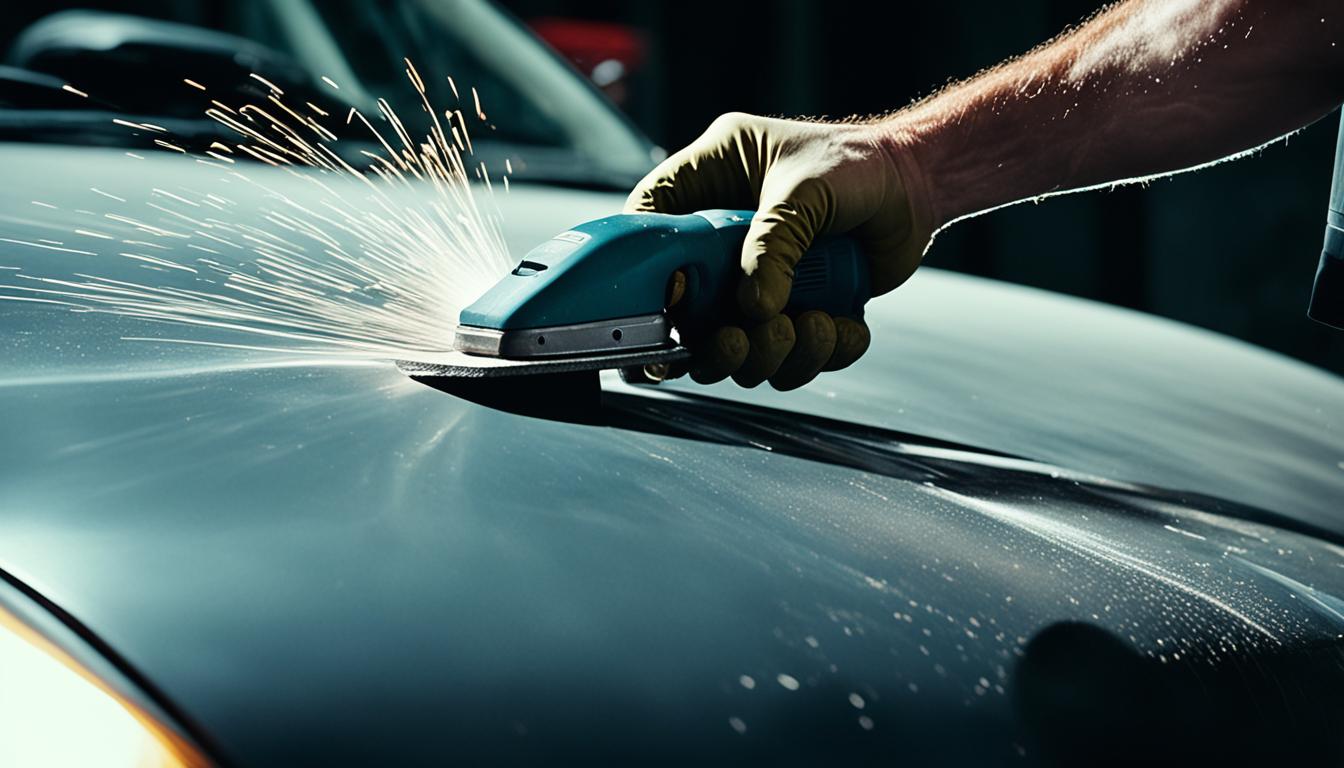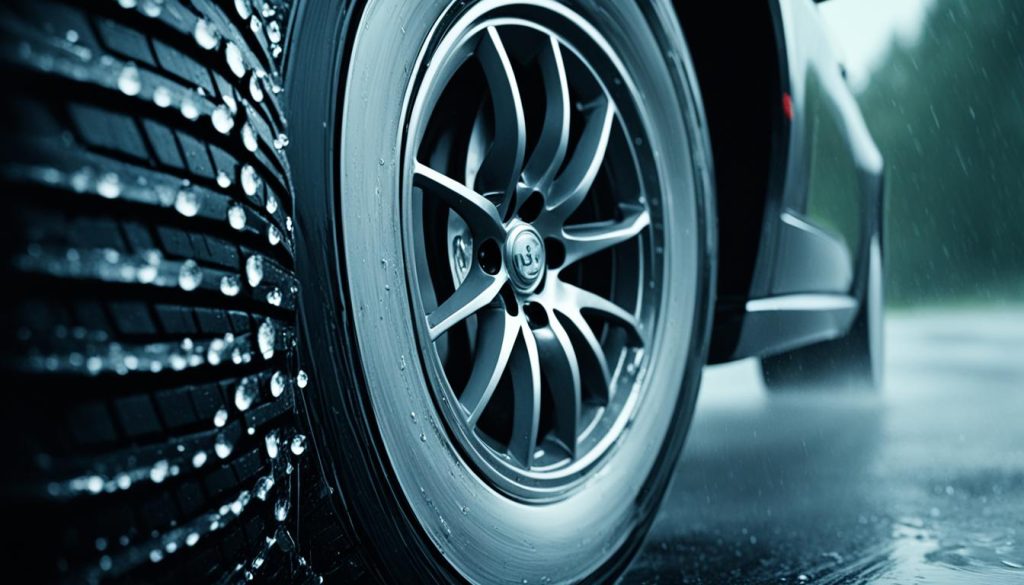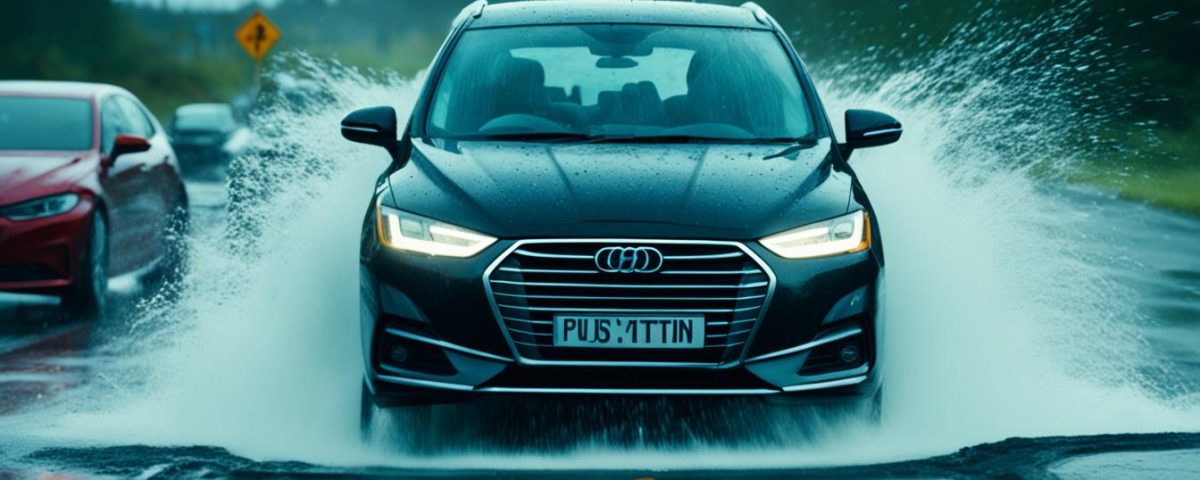
Decoding Policies: Understanding Your Auto Insurance for Repairs

Revitalize Your Ride: The Art of Auto Body Repair
When it comes to wet road safety, one of the biggest concerns is hydroplaning. This dangerous phenomenon occurs when a vehicle’s tires lose contact with the road surface due to a layer of water, leading to a loss of control and potential accidents. At Miracle Body and Paint, we prioritize your safety on the road, which is why we’ve compiled essential tips to help you prevent hydroplaning and maintain traction on wet roads.
Key Takeaways:
- Hydroplaning is the loss of traction when tires encounter more water than they can scatter.
- Factors such as high speeds, worn-out tires, insufficient tire tread depth, and improper tire inflation can cause hydroplaning.
- Enhancing traction through proper tire maintenance, regular vehicle checks, and driving techniques is crucial.
- Ensure your tires have adequate tread depth, maintain recommended tire inflation, and consider using tires designed for wet conditions.
- Seek professional assistance from an auto body shop like Miracle Body and Paint for collision repair and expert guidance on hydroplaning prevention.
Understanding Hydroplaning
Hydroplaning is a perilous situation that occurs when a vehicle’s tires encounter more water than they can scatter, resulting in a loss of traction. Understanding the causes of hydroplaning is crucial to effectively prevent this hazardous occurrence.
There are multiple factors that contribute to hydroplaning:
- High speeds: Driving too fast through wet conditions increases the likelihood of hydroplaning. The faster you go, the harder it is for your tires to push water away.
- Worn-out tires: Tires with worn tread patterns have a reduced ability to disperse water, making them more prone to losing grip on wet surfaces.
- Insufficient tire tread depth: Inadequate tread depth hinders the tire’s ability to evacuate water, leading to a higher risk of hydroplaning.
- Improper tire inflation: Underinflated tires create a smaller contact patch with the road, increasing the chances of hydroplaning.
By comprehending these causes, you can take proactive measures to prevent hydroplaning and ensure your safety on wet roads. Stay vigilant and implement the necessary precautions to maintain vehicle control and minimize the risks associated with hydroplaning.
Stay tuned for the next section where we’ll delve into the importance of traction enhancement and how it contributes to preventing hydroplaning.
Importance of Traction Enhancement
Maintaining traction is crucial for preventing hydroplaning and ensuring wet road safety. Good traction allows your tires to grip the road surface effectively, even in slippery conditions. To enhance traction and improve tire grip, we recommend the following:
- Proper tire inflation: Ensure that your tires are inflated to the recommended pressure levels provided by the vehicle manufacturer. Underinflated tires reduce the contact patch between the tires and the road, increasing the risk of hydroplaning. Regularly check your tire pressure and maintain it as recommended.
- Regular tire tread depth checks: Adequate tire tread depth is essential for optimal grip on wet roads. The grooves in tire tread are designed to disperse water and maintain traction. Use a tread depth gauge to measure the depth of your tire treads regularly. If the tread depth reaches 4/32 of an inch or below, it is recommended to replace your tires.
- Tires designed for wet road conditions: Consider using tires specifically designed for wet road conditions. These tires are designed with tread patterns and compounds that enhance traction and performance on wet surfaces. Look for tires with good wet traction ratings and consult with a professional to determine the best tire options for your vehicle.
By implementing these traction enhancement measures, you can improve your vehicle’s grip on wet roads, reduce the risk of hydroplaning, and enhance overall wet road safety.
Regular Maintenance for Safe Driving
Proper vehicle maintenance is essential for safe driving on wet roads. Regularly checking and maintaining your vehicle’s components not only enhances performance but also improves wet road safety. Here are some key maintenance tasks to prioritize:
- Inspect Your Tires: Regularly check your tires for signs of wear and tear, including cracks, bulges, or uneven tread wear. These issues can greatly affect tire traction on wet surfaces. If you notice any abnormalities, it’s crucial to replace your tires promptly to maintain optimal grip.
- Rotate Your Tires: Rotating your tires at recommended intervals helps ensure even tire wear, allowing for consistent performance. This improves overall road grip in wet conditions, providing you with better control over your vehicle.
- Maintain Brakes, Suspension, and Steering: Adequately functioning brakes, suspension, and steering systems contribute to overall road grip and safety. Regularly inspect these components for any signs of damage or malfunction and have them serviced by a professional, if needed.
By prioritizing regular maintenance tasks, you can significantly reduce the risk of hydroplaning and ensure safer driving on wet roads.
Driving Techniques for Wet Conditions
When facing wet road conditions, it is crucial to adjust your driving techniques to ensure your safety. By implementing the following tips, you can navigate through the rain with confidence and reduce the risk of accidents:
- Reduce your speed: Driving at a slower pace allows for better control of your vehicle on slippery roads. Lowering your speed gives you more time to react to unexpected situations and helps prevent skidding or hydroplaning.
- Avoid sudden maneuvers: To maintain traction, it is essential to avoid sudden and aggressive maneuvers such as harsh braking or accelerating. These abrupt movements can cause your tires to lose traction, leading to a loss of control over your vehicle.
- Increase your following distance: It is advisable to increase the distance between your vehicle and the one in front of you. This extra space provides more reaction time and allows for smoother braking, reducing the chances of a collision.
Remember, safe driving in the rain involves making smooth and gradual movements. By adjusting your speed, avoiding sudden maneuvers, and increasing your following distance, you can enhance tire traction and ensure a safer journey on wet roads.

Importance of Proper Tire Tread Depth
Adequate tire tread depth is crucial for maintaining traction and preventing hydroplaning on wet roads. The grooves in tire tread are specifically designed to disperse water and provide grip, ensuring your vehicle stays in control even in challenging conditions.
To assess whether your tires have sufficient tread depth, you can perform a simple test using a penny. Insert the penny into one of the tire grooves with Lincoln’s head facing down. If you can see the top of Lincoln’s head, it indicates that your tire tread depth is below the recommended level.
It is generally recommended to replace tires when the tread depth reaches 4/32 of an inch. However, in wet climates or areas with frequent rainfall, experts suggest replacing tires at 6/32 of an inch to maintain optimal wet road traction. Regularly checking your tire tread depth ensures that you have adequate grip and reduces the risk of hydroplaning.
The dangers of insufficient tire tread depth:
- Reduced traction: Worn-out tires with shallow tread depth have limited ability to channel water away, resulting in decreased traction on wet roads.
- Increased stopping distance: Insufficient tire tread depth extends the time it takes for your vehicle to come to a stop, increasing the risk of accidents.
- Poor handling: A lack of tire grip affects your vehicle’s stability and maneuverability, making it more challenging to navigate wet road conditions.
Regularly checking your tire tread depth is a vital part of tire maintenance. By ensuring your tires have adequate grip and replacing them when necessary, you can significantly enhance your safety on wet roads.
The Role of Tire Inflation
Proper tire inflation plays a crucial role in ensuring optimal traction on wet roads. When your tires are underinflated, it reduces the contact patch between the tires and the road, increasing the risk of hydroplaning. This occurs when a layer of water separates the tires from the road surface, leading to a loss of control over the vehicle. To mitigate this risk and enhance your safety on wet roads, it is essential to regularly check your tire pressure and maintain it at the recommended levels provided by the vehicle manufacturer.
By paying attention to tire pressure, you can enhance grip and stability, reducing the likelihood of hydroplaning incidents. When tires are properly inflated, the entire tread area comes into contact with the road, increasing traction and improving control.
The Impact of Underinflation:
When your tire pressure is too low, there are a few key consequences that can compromise your safety on wet roads:
- Reduced Contact Patch: Underinflated tires have a smaller contact patch with the road surface, resulting in decreased traction. This decreases the tire’s ability to disperse water effectively, increasing the likelihood of hydroplaning.
- Poor Handling: When the tire pressure is low, the sidewalls of the tire may flex excessively. This reduces the responsiveness of the tire, making it more difficult to steer and maneuver the vehicle safely in wet conditions.
- Increased Rolling Resistance: Underinflated tires can lead to increased rolling resistance, putting additional strain on the engine and reducing fuel efficiency. By maintaining proper tire inflation, you can optimize fuel economy and reduce unnecessary wear and tear on your vehicle.
Regular Tire Pressure Checks:
To ensure proper tire inflation and wet road safety, it is important to regularly check your tire pressure. Tire pressure can fluctuate due to changes in temperature and normal wear and tear. By following these steps, you can maintain optimal tire pressure:
- Refer to your vehicle owner’s manual or the placard located on the driver’s door jamb to find the recommended tire pressure for your specific make and model.
- Use a reliable tire pressure gauge to check the pressure in each tire.
- If the pressure is below the recommended level, add air until it reaches the proper PSI (pounds per square inch) value. Ensure to check the pressure when the tires are cold.
- Repeat this process at regular intervals to keep your tire pressure within the recommended range.
By incorporating regular tire pressure checks into your maintenance routine, you can ensure your tires are properly inflated, reducing the risk of hydroplaning and enhancing your safety on wet road surfaces.
Importance of Anti-Lock Braking System (ABS)
An Anti-Lock Braking System (ABS) is a crucial component of modern vehicles that plays a significant role in ensuring safe braking, especially in challenging conditions such as rain and wet roads. ABS helps prevent wheel lock-up during braking, allowing the driver to maintain steering control and avoid skidding.
When you apply the brakes on a wet road, the water film between the tires and the road surface can reduce the overall friction, making it easier for the wheels to lock up. This loss of traction can result in loss of control and increase the risk of accidents. However, with an ABS in place, the system actively monitors the wheel speed and adjusts the brake pressure to prevent lock-up, maximizing the grip between the tires and the road.
By maintaining wheel rotation and preventing skidding, ABS ensures that you can maintain control of the vehicle, even during emergency braking situations. This not only enhances your safety but also minimizes the chances of collisions with other vehicles or obstacles on the road.
It is important to regularly check your ABS system to ensure it is functioning properly. If you experience any issues, such as the ABS warning light illuminating on your dashboard, it is recommended to consult a professional mechanic or visit an authorized service center for diagnosis and repair.

The Role of Vehicle Stability Control (VSC)
When it comes to wet road safety, having a reliable Vehicle Stability Control (VSC) system is essential. VSC is designed to assist drivers in maintaining control during slippery conditions, such as when driving on wet roads. By adjusting engine power and applying individual wheel braking, VSC helps prevent spinouts and skids, ensuring maximum stability and control.
It is crucial to ensure that your VSC system is working correctly. Regularly check for any warning lights on your dashboard that indicate a malfunction in the VSC system. Familiarize yourself with your vehicle’s user manual to understand how to operate and make the most of your VSC system.
When driving on wet roads, VSC can make a significant difference in your safety. By keeping your vehicle stable and reducing the risk of skidding or losing control, VSC contributes to safer and more confident driving experiences, even in challenging conditions.
If your vehicle does not have a VSC system, consider upgrading to a vehicle equipped with this advanced safety feature. Investing in a car with VSC can help enhance your wet road safety and provide you with peace of mind behind the wheel.
In addition to VSC, there are other factors to consider when it comes to wet road safety. Proper tire maintenance, including regular checks for tread depth and inflation, is crucial. Driving techniques such as reducing speed, avoiding sudden maneuvers, and maintaining a safe distance from other vehicles also contribute to safer driving on wet roads.
By prioritizing wet road safety and utilizing systems like VSC, you can protect yourself and those around you from the hazards of hydroplaning and ensure a safer and more enjoyable driving experience.
Choosing the Right Tires for Wet Road Safety
Selecting the right tires is crucial for ensuring your safety on wet roads. To enhance traction and prevent hydroplaning, consider the following tips:
- Look for tires with good wet traction ratings: When shopping for tires, pay attention to their wet traction ratings. These ratings indicate how well the tires perform in wet conditions and provide a good indication of their ability to maintain grip on wet roads.
- Consider options specifically designed for wet conditions: Some tire models are specifically designed to handle wet road conditions. These tires often have unique tread patterns and rubber compounds that improve traction on wet surfaces. Look for tires labeled as “wet road” or “rain” tires for optimal performance.
- Opt for all-season tires with the M+S or 3PMSF symbol: All-season tires with the M+S (mud and snow) or the 3PMSF (Three-Peak Mountain Snowflake) symbol are suitable for driving on wet roads. These tires are designed to perform well in various weather conditions, including wet and snowy roads.
- Consult with a professional: When in doubt, consult with a tire professional or a reputable tire shop. They can provide expert advice and help you select the best tires for your specific vehicle and driving needs.
Investing in the right tires for wet road safety is an essential step towards maintaining traction and preventing hydroplaning. Remember to regularly inspect your tires for wear and tear, and replace them when necessary to ensure optimal performance.
Seeking Professional Assistance
If you have been involved in a hydroplaning accident or need assistance with hydroplaning prevention, we highly recommend reaching out to a reputable auto body shop and collision center like Miracle Body and Paint in San Antonio. Our team of experts is dedicated to providing top-notch services to keep you safe on wet roads.
At Miracle Body and Paint, we understand the importance of hydroplaning prevention and prioritize your safety. Our experienced technicians have the expertise to guide you through the necessary steps, ensuring your vehicle is inspected for any potential issues and offering tailored solutions to enhance traction and control.
When you choose our auto body shop for collision repair and hydroplaning prevention, you can trust that your vehicle will be in good hands. We stay updated on the latest industry standards and use advanced techniques and state-of-the-art equipment to deliver outstanding results.
Whether it’s fixing damages caused by hydroplaning accidents or implementing preventive measures, our team is committed to helping you restore your vehicle’s safety and performance. With our expertise and attention to detail, you can have peace of mind knowing your vehicle will be roadworthy and well-prepared for wet conditions.
Don’t compromise on your safety. Contact Miracle Body and Paint today and let us assist you with your hydroplaning prevention needs and collision repairs. Your safety is our priority, and we are here to provide you with exceptional service and support.
Conclusion
Ensuring your safety and the safety of others on the road is of utmost importance, especially when it comes to preventing hydroplaning on wet roads. By following these essential hydroplaning prevention tips and maintaining proper tire traction, you can significantly enhance your vehicle’s grip in wet conditions.
Remember to regularly check your tire tread depth and tire inflation, as these factors play a crucial role in preventing hydroplaning. Additionally, adapting your driving techniques to wet conditions, such as reducing speed and avoiding sudden maneuvers, can greatly reduce the risk of losing control on slippery roads.
If you do find yourself involved in a hydroplaning accident or need assistance with hydroplaning prevention, consider seeking professional help. Miracle Body and Paint, a reputable auto body shop and collision center in San Antonio, is dedicated to providing top-quality services and keeping your vehicle in optimum condition for safe driving. Feel free to reach out to our team of experts who can inspect your vehicle, offer professional advice, and provide solutions to ensure your safety on wet roads.



